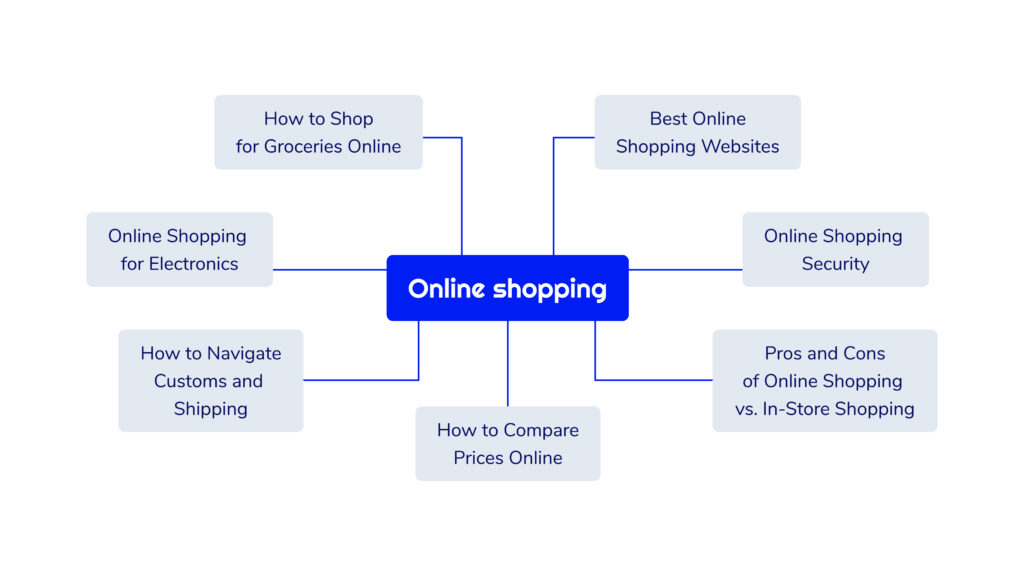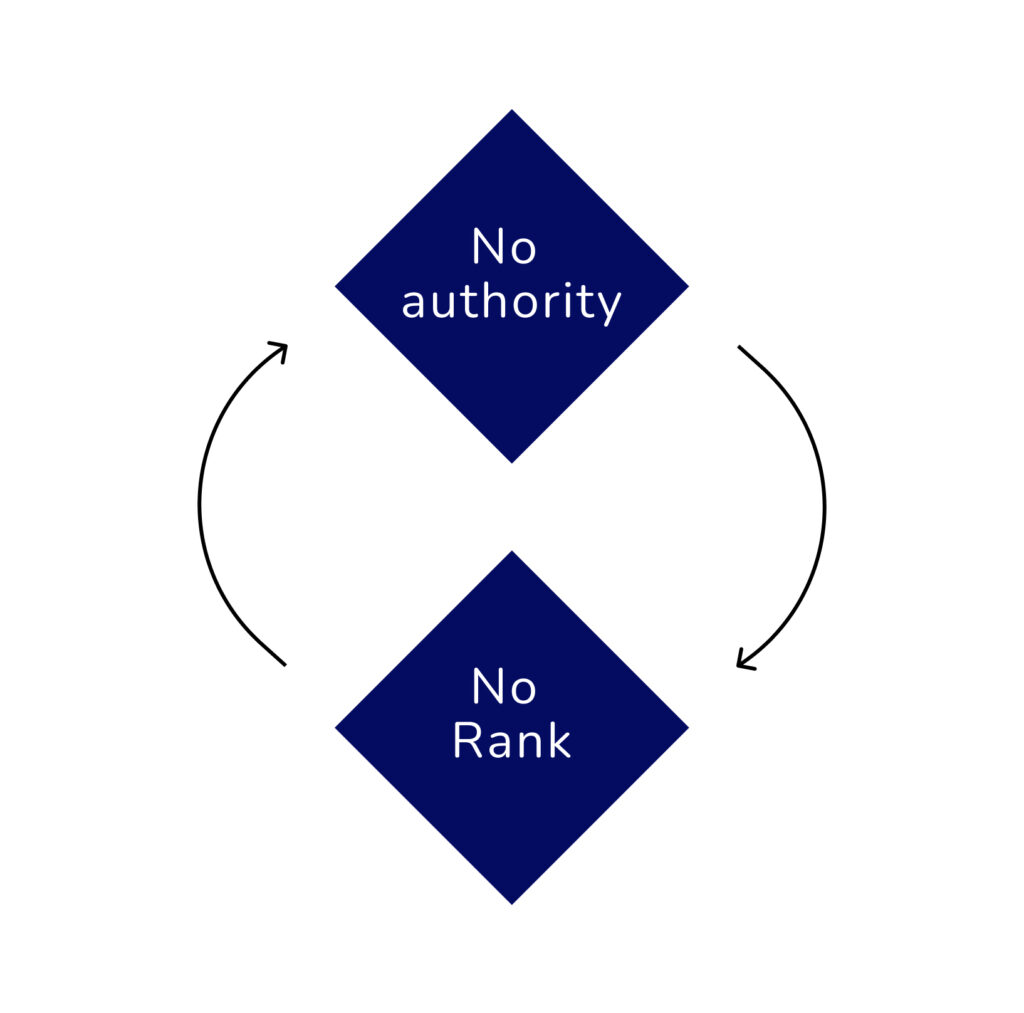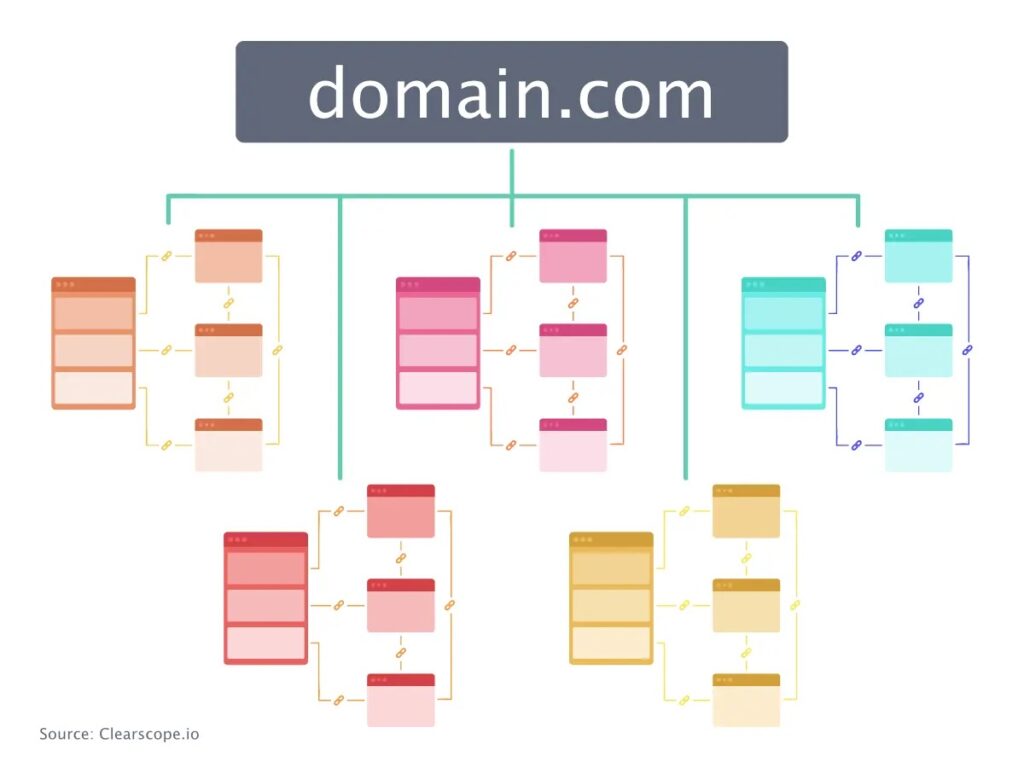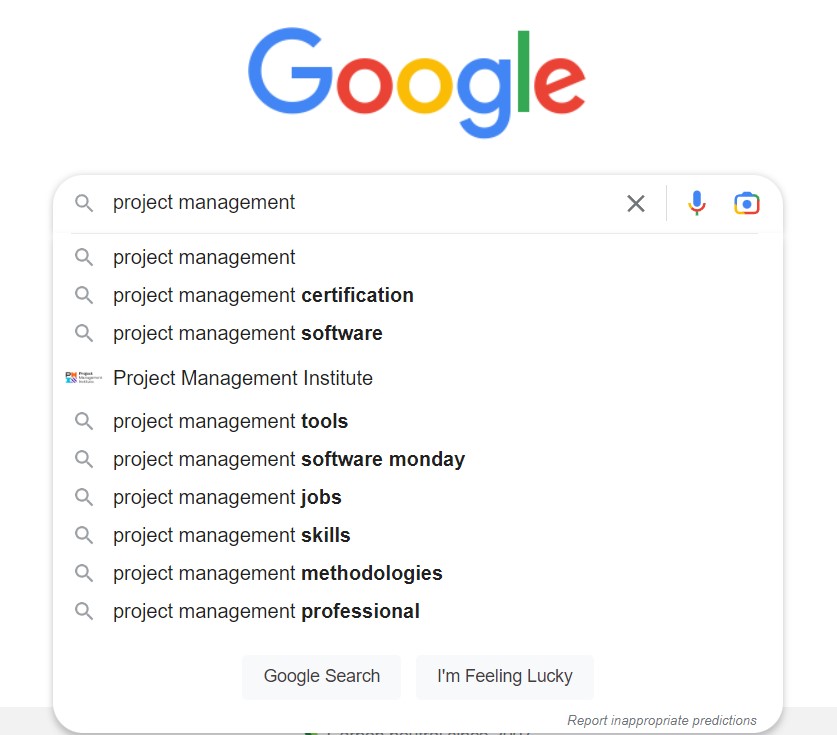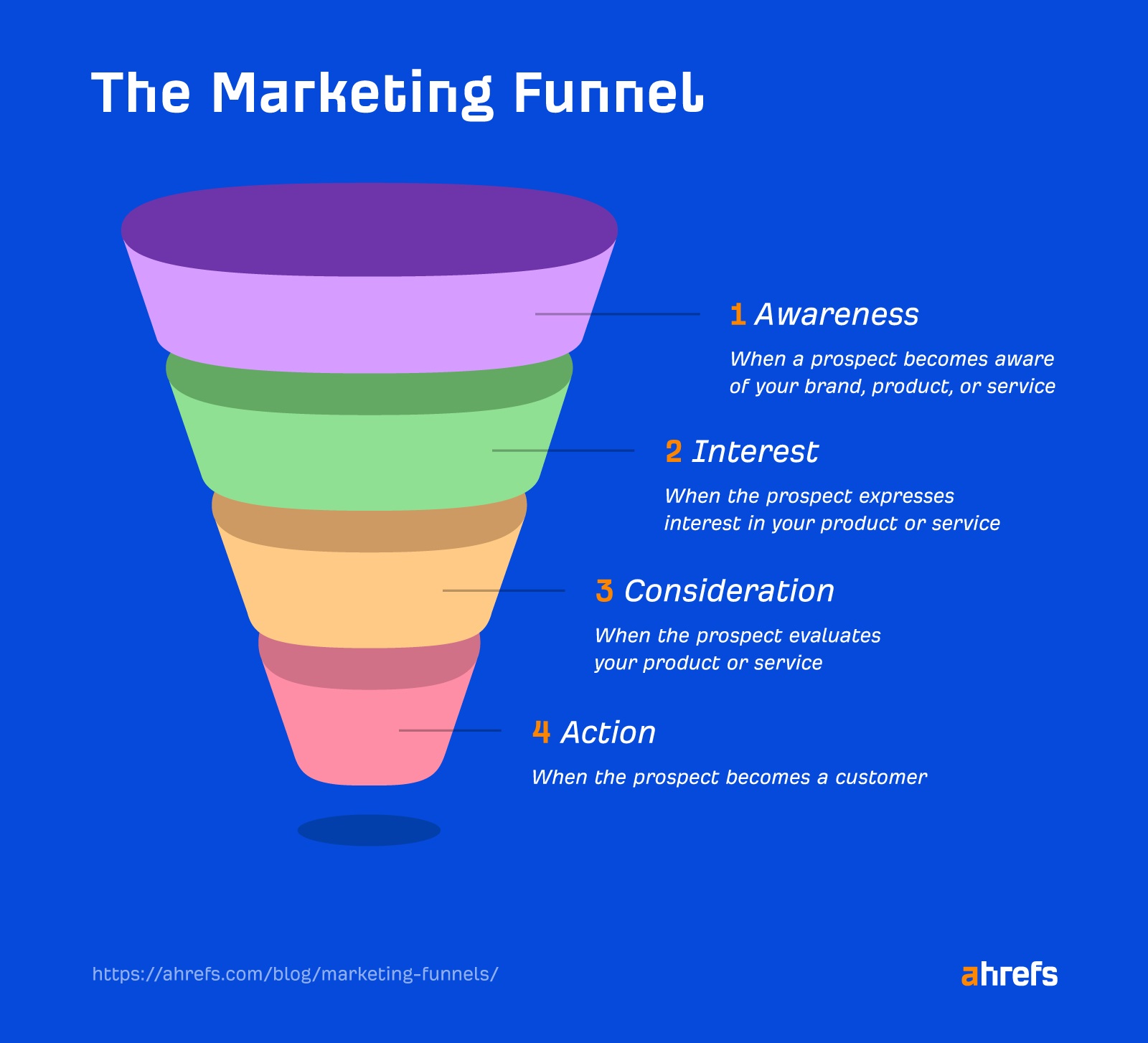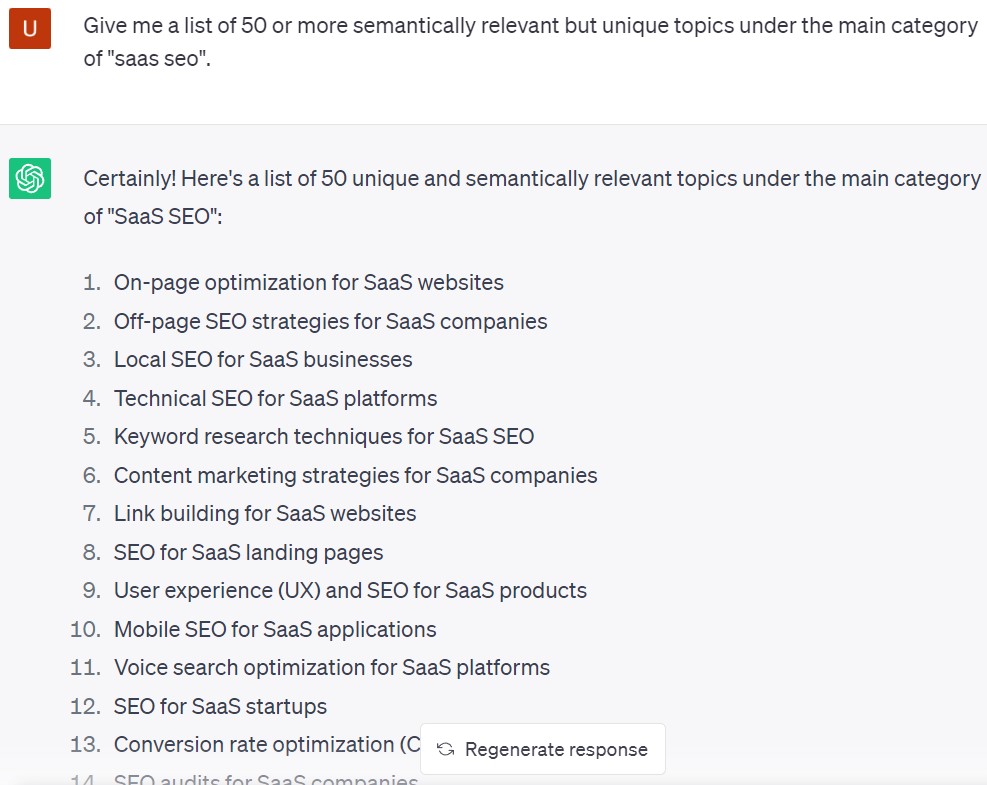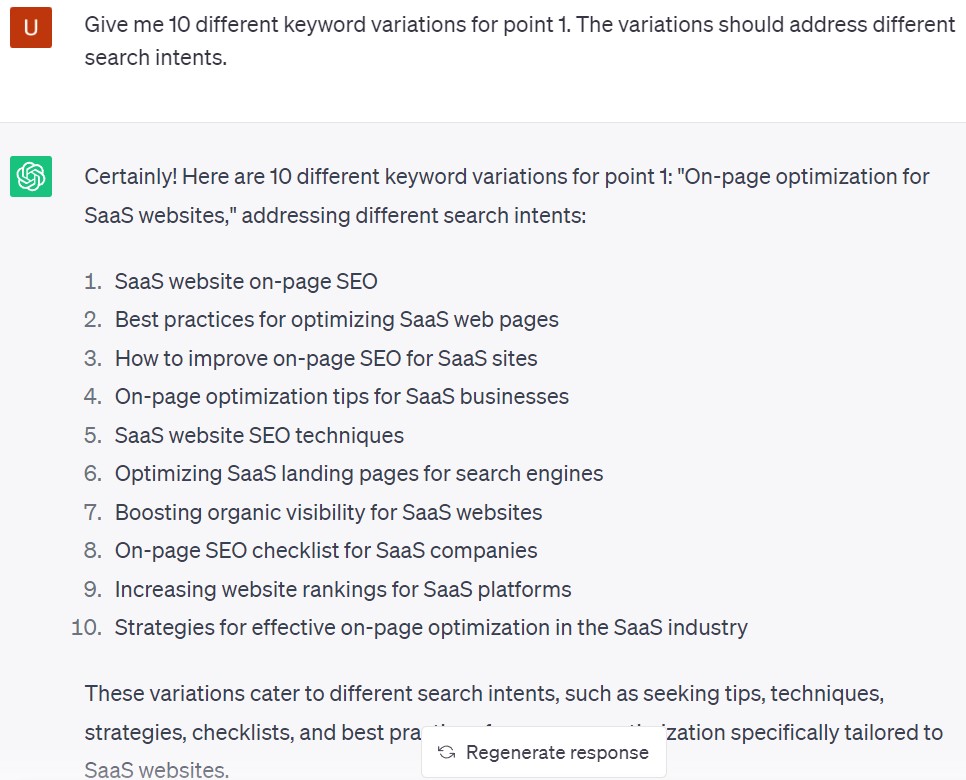
When the concept of content clusters first surfaced with Google’s mid-2010s ML-powered search algorithm updates, former HubSpot team member Anum Hussain conducted some experiments that revealed some interesting results. Among many other valuable insights, her team found that the more interlinked related content they published on a particular subject, the higher their website ranked in Google SERPs for not just that subject but also its subtopics.
Over time, the power and potential of the topic cluster model have been further cemented by real-life examples. Many successful businesses and content marketers have benefitted from this content marketing strategy. For instance, YouTuber Matt Diggity’s team helped one of their clients achieve a whopping 3000% increase in website traffic by deploying cluster content.
We’ve compiled a 7-step tried-and-tested formula to building the perfect content cluster, with some handy tips along with some bad practices you must be careful about.
PLUS A BONUS TIP How to Use Chatbot GPT to speed up the process.
What is a content cluster?
A content cluster, also known as the topic cluster or hub-and-spoke model, is an organised collection of articles written on subtopics that are all related to a broader parent topic, thereby forming a cluster.
Every topic cluster consists of two main components:
- The pillar page: This is the main topic that you want your website to rank for.
- The cluster pages or cluster content: These are the supporting articles which are written on specific subtopics that stem from the pillar’s main topic.
You can think of a content cluster as a tree, where all the branches trace back to the root. Some branches are interconnected, too, forming a nice, cosy network.
Here’s a simple example of how you can create a content cluster for the pillar topic “online shopping” with supporting cluster content about comparing prices online, online vs in-store shopping, and numerous other subtopics.
Caption: Basic content cluster example
For businesses, the primary goal of the content cluster strategy is to establish authority. Domains that have already achieved this trusted status are often able to rank easily for a topic just by writing a single article on it. Newer or lesser authoritative websites often find themselves stuck in this vicious cycle where
- They are not able to rank because search engines don’t see them as trustworthy and authoritative
- They struggle with establishing trust, authority, and popularity because of not being able to rank
Implementing a topic cluster strategy is the perfect solution to this problem. By targeting cluster keywords, which are generally less competitive (at least in the beginning), you get a kick-start. Plus, producing large amounts of content on the same parent topic convinces search engines to acknowledge your authority and treat you as an expert on that specific problem.
Another major advantage of content clustering is that it shifts the focus from keywords to topics, thus forcing websites to give up the many black hat strategies often followed in the name of SEO, such as keyword stuffing and backlink buying.
Ultimately, the goal in the long term is to improve the quality of content shown to search engine users.
Why topic clusters are important for you
Content clusters are key to meeting the criteria laid out by Google’sEEAT principle: Experience, Expertise, Authoritativeness, and Trustworthiness. Implementing topic clusters on your website can bring numerous benefits to your business’s website. Let’s delve into why topic clusters are so important and how they can support your online presence.
1. Organise your website content
The central pillar page and its related cluster pages help create a clear roadmap for both search engines and website visitors to navigate your website effortlessly. Topic clusters thus help organise your website content in a user-friendly and intuitive way. Clustering also lends improved crawlability and accessibility to your site, boosting search visibility and rankings and enhancing user experience.
2. Interlink relevant resources
As a crucial aspect of content clustering, internal linking connects different web pages within the same domain. It has a significant impact on a website’s SEO by enabling search engines to recognise the semantic links between the pillar and its supporting cluster pages. By strategically incorporating internal links, you provide search engines with a better understanding of the relevance and hierarchy of your content.
And that’s not all. External links that are relevant to your topic or subtopics also hold high value. By linking to reputable external sources, you prove your effort and dedication towards providing complete and verified information to your audience, passing on some of that authority to your own website.
3. Convert readers into buyers
Content clusters aim to not only attract readers but also eventually convert them into buyers. You have to strategically lead your target audience through a series of related content pieces that spark their interest and convince them to take the desired action at each step of their journey.
Even if readers initially arrive at your website with broad searches and little to no intention to make a purchase, an intelligently created content cluster can gently nudge them towards acknowledging their need for your product or service and, in the last stage, finally buying it.
4. Build topical authority and increase traffic
Content clusters provide an excellent opportunity to establish your authority in the specific niche in which your website or business operates. By consistently putting out valuable content that exhibits contextual relevance as well as subject matter knowledge, you will successfully position yourself as an expert. This will have a two-fold advantage.
- It will signal to search engines that you are a trustworthy source of information. Consequently, your website will be more likely to be ranked higher on the search engine results pages (SERPs). Take Forbes or Medium, for instance. They have produced clusters upon clusters of content in numerous niches, so much so that now, even if they publish one new article on a new topic, there’s a high chance it will rank with little to no effort. Such domains can be hard to compete with. If you want your website to achieve this level of authority, content clustering can give you that much-needed assist.
- It will help you earn the trust of your target audience, who will then potentially also be more open to considering buying your product or service in the future.
The increased search visibility will help drive more organic traffic to your site, expanding your reach and potentially attracting a larger, more relevant audience that’s actively interested in your offerings.
5. Offer comprehensive content
With content clusters, you get the perfect chance to offer complete information on a specific subject, analysing it from all possible angles. This means you can increase your chances of ranking for a wide range of keywords related to the same topic.
Also, by targeting different types of users with different clusters, you can win a truly diverse audience. Some readers might be interested in a surface-level, introductory article on a topic. Some might want to get advanced insights or practical tips. Others might be looking for a detailed comparison between two related products before they finalise a purchase. A cluster will help meet the needs of all these groups.
Both of the above can help you capture a sizeable market share for each topic you create cluster content for.
How to build a content cluster
1. Find the parent topic for your pillar page
The parent topic is the topic that you want to rank for. Thus, it is the central theme around which your entire cluster will revolve. Deciding on a parent topic for your pillar page and cluster pages is the first step to building a content cluster, but how exactly do you decide what to focus on?
In trying to chase “trending” topics to create traffic-generating content, many businesses forget to consider the services or products they provide. Your offerings play a key role in helping identify the core topics for your pillar pages. Your content cluster must align with your offerings and establish your expertise in those areas. For example, if you are an enterprise SaaS company and you start writing about the latest gossip in the entertainment industry, the traffic you get from such content will contribute nothing to your software subscriptions.
While there are numerous other ways to go about selecting your parent topic too, what truly matters is that you give your target audience what is relevant to them. What do your readers want to know? What are they searching for? Are there any common queries that you get from existing customers (or potential ones) about certain topics? Put yourself in their shoes and think about the questions they might have.
Also, find out what your closest competitors are writing about. What’s trending on Google? Check FAQs, People Also Ask (PAA) boxes, and search engine autocomplete suggestions too. These can give you valuable insights into topics that are already popular within your niche.
There are certain tools you can use to help you find the answers to the above questions. These includeAnswerThePublic,Answer Socrates, and the trusty Ahrefs Keyword Explorer.
2. Explore subtopics
Once you’ve finalised your parent topic, you need to start choosing the subtopics that your cluster pages are to be based on. Each cluster page needs its own unique topic with a dedicated search intent. However, it is also important to remember that your target audience might consist of many different people, all atdifferent stages of the customer journey.
For instance, some readers could be at the top of the sales funnel, which is the awareness stage. They’re probably just looking to learn about a specific topic and hence interested in articles containing meaningful informational or educational content, facts, insights, or maybe some practical tips.
Let’s say you want to rank for a parent topic, “project management”. Sub-topics such as “How does technology help in project management?” or “7 pros and cons of project management software” could help you cater to the informational intent at this stage.
Readers in the middle of the sales funnel, aka the consideration stage, might be looking for more in-depth information about specific products or services associated with your main topic. They need articles that address very specific issues, such as comparative analyses, product reviews, case studies, expert guides, or genuine advice that could help them as they mull over possible options. “5 best project management software” is a great example for this intent.
At the bottom of the sales funnel, which is the decision phase, readers are more focused on finalising their purchase decision. It’s about to go down – they’re ready to buy! The primary goal here is to highlight how your specific product can address your customers’ pain points. You can help answer their last-minute questions or doubts with product-oriented articles containing demos, testimonials, pricing info, or exclusive offers that serve as the final act of encouragement, e.g., “5 must-try features in the latest update for our project management software”.
This tiered approach not only increases the relevance of your content but also helps guide readers through the conversion funnel, providing them with the information they might need at each step. Thus, it is always good to have different articles within the same cluster to address different search intents. The trick is to strike a balance between addressing different search intents and maintaining a cohesive theme within your content cluster.
3. Choose your keywords
Once you have all the topics, you can begin your content creation process, which starts with keyword research, where you find all relevant keywords to be included in your write-ups for maximum search engine optimisation.
There are many ways to search for keywords. Different marketers prefer different methods, depending on their preferences or their content marketing goals. But there are certain practices that have objectively proved successful.
For starters, you can leverage powerful tools like Semrush’s Keyword Magic Tool or Ahrefs’ Keywords Explorer. There’s also Surfer SEO’s Keyword Research feature, which, for any parent keyword you input, automatically populates keyword clusters based on semantic commonalities, intent, and other characteristics. These tools provide essential insights into search volume, keyword difficulty, and other attributes. Generic searches like these can produce some irrelevant or redundant results, though. So, after your initial search, make sure to filter out all keywords that are not related to your main topic.
One of our favourite methods for keyword selection has been put together by the experts at Minuttia. It is a super-comprehensive technique which takes into consideration basic keyword characteristics such as keyword difficulty and search volume. But on top of that, it also explores the importance of several other parameters that often go ignored in the typical keyword research process. These include search intent, topical relevance, cost-per-click, difficulty score, and business value.
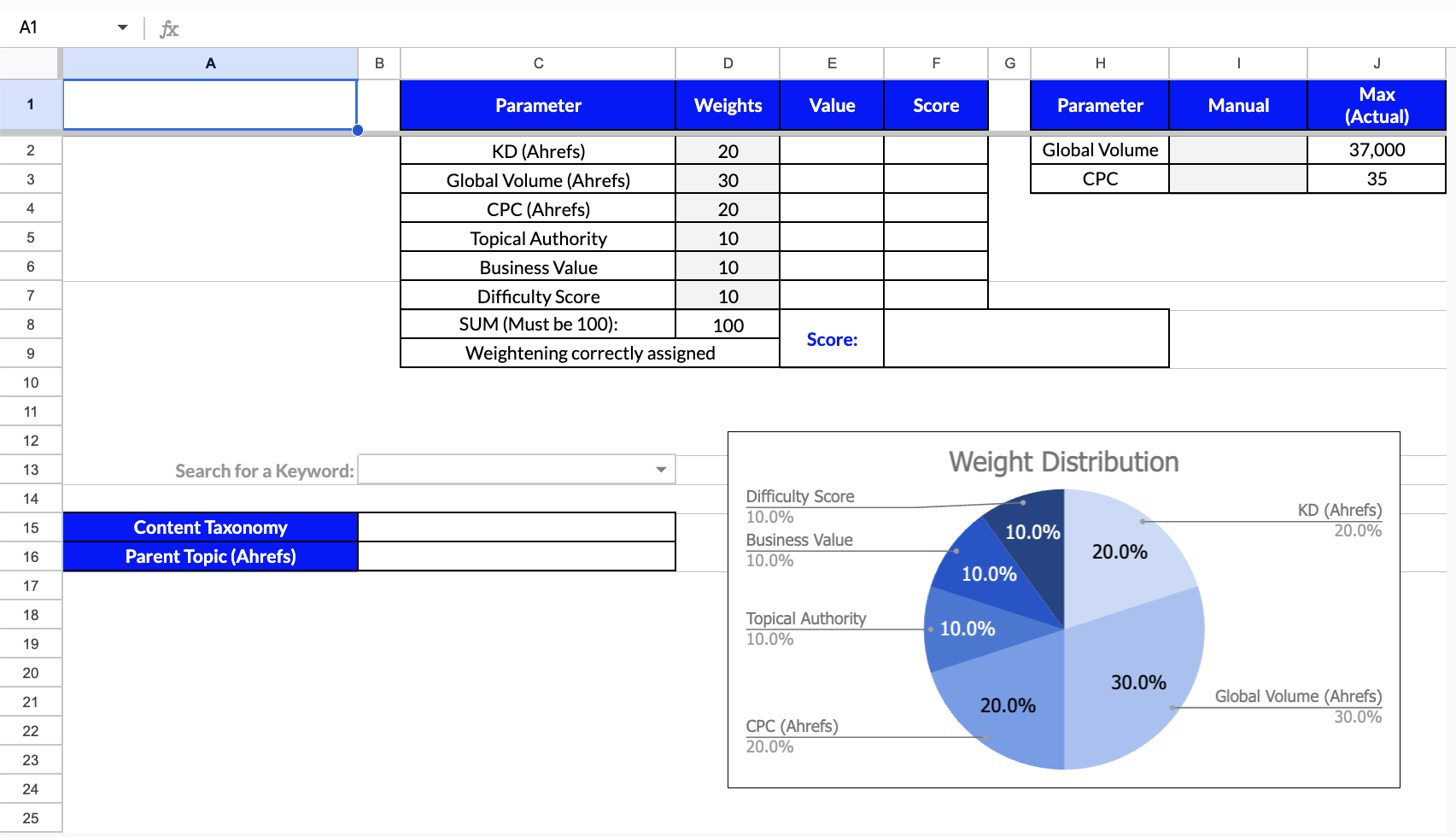
They use this combination of factors and assign them weights according to their relative importance to further calculate the opportunity score for each keyword. The goal is to base your keyword selection on more accurate metrics instead of simply pulling meaningless data from the first free keyword tool you can find online.
Next comes the process of categorising your keywords into pillar and cluster topics based on various factors.
For example, since the bigger goal here is to rank for the pillar topic, it is preferred that the keywords with higher search volumes be categorised as pillar keywords. Similarly, keywords with the highest volumes are often also much harder to rank too, so it would only be natural for pillar keywords to have higher difficulty scores – nothing to be worried about!
Keywords with lower volumes are usually the ones that are more specific, often long-tail, and with lower keyword difficulty, which is the ideal combination for ranking cluster pages in most cases. Just make sure all the keywords in one cluster are related to the main topic on some way. Also important to remember: One cluster page should preferably cater to only one type of search intent, but not all cluster pages should address the same intent.
4. Create the content
For each article, whether it’s a pillar or cluster page, prepare a content brief to properly plan out the piece before you start writing it. This helps avoid any major (potentially expensive and time-consuming) mess-ups later during or after the writing process.
Content briefs are especially useful if someone other than yourself will be doing the writing because they effectively communicate all the requirements. You can then assign the article to your best writer, who can easily follow the content and SEO instructions to prepare a write-up that perfectly matches your brand and meets your business goals.
Don’t forget to include some creative visuals within your written content. A bunch of relevant images that are well-optimised for a great user experience can do wonders for your content’s SEO. So make sure any images you include have been properly named, have accurate yet SEO-friendly alt tags and captions, are mobile-friendly, and have been compressed to appropriate file sizes.
5. Internal linking
To build cohesive content clusters, you need to tell search engines exactly how their component pages are interconnected. This is done via internal linking. It’s a seemingly simple process but actually needs a lot of strategic thinking.
We’ve already talked about some of the reasons why internal linking is a key part of the content clustering strategy.
- It ensures that different content pieces within a cluster are properly interconnected in a way that is UX-friendly and facilitates manual and search-engine navigation
- It tells the search engines which pages are most important for a certain topic
- It encourages engagement by making interrelated content more noticeable and discoverable
- It inculcates domain authority by passing link juice between cluster pages, which reinforces that you possess enough knowledge on a subject to have been able to produce a substantial amount of content on it
Businesses can easily go wrong with internal linking; they tend to get carried away. So here are some tips to help you with the correct implementation.
Select the right anchor text
Use descriptive and relevant anchor text that accurately represents the linked content. This helps both readers and search engines understand the context of the link.
Avoid overstuffing
While internal links are a key part of a content cluster, you should be careful not to overload your content with too many of them. Going overboard with internal links can make your content cluttered, inaccessible, and difficult to read, ruining the user experience.
Don’t create and forget
Make sure all your internal links are working properly with regular monitoring. Conduct an audit from time to time. Broken links wreck the user experience and cause navigational issues. If you want to provide your website visitors with a smooth browsing experience, you must fix your broken links ASAP.
6. Promotion
Once your content cluster is published, you need to promote it externally too. No matter how great your content quality or on-page SEO efforts are, it can still often be difficult to rank without some external help. Here are some ways you can promote your content.
Earning backlinks
This is one of the most powerful methods to lend your content some much-needed authority. While it is entirely possible to gain top search positions by focusing on ranking factors other than backlinks, it can be difficult to maintain that rank. Backlinks are thus necessary for your cluster to be a constant presence on the SERPs. There are many ethical yet easy ways to gain backlinks, such as looking out for mentions of your brand, creating list posts, and answering HARO queries.
Check out our SaaS SEO case study to see how we leveraged link-building to boost our client’s search rankings.
Sharing on social media
Social media platforms are one of the best ways to get the word out about anything and everything. You get access to an existing global audience which you can filter according to your targets or preferences.
Additionally, instead of just posting your content links on your business profile, you could look into collaborations with influencers or other experts in your niche who can help you reach an even broader audience.
You can also use the different social media post formats, e.g., infographics, reels, and polls, to encourage the audience to click through to your cluster articles.
Publishing newsletters
If you have a significant subscriber list, you can send out periodic emails to your readers in the form of a newsletter. You can also divide each content cluster into smaller groups for better targeting and only include links to a set number of articles at a time. Arrange and design the newsletter in such a way that recipients are motivated to click on the provided links.
Guest posting
This is an excellent way to directly or indirectly promote your content cluster. You can reach out to third-party websites and offer to write a bunch of articles for them on your pillar topic or its variations. You can then insert backlinks to your cluster content, citing them as reliable information sources. This helps indirectly boost your content’s visibility and authority.
7. Maintenance
You’re almost done building the perfect content cluster – this is the last step!
If you want to stay in the game, you need to keep all your cluster content always fresh, relevant to your audience, and valuable through the years. Here are some tips for essential monitoring and maintenance of your content.
Update your content
Industry trends are perpetually evolving, and there is always new information being released. Thus, it’s good practice to periodically scan your content and explore any new opportunities to add the latest insights or statistics. Also, make sure to refresh any outdated information or references to ensure factual accuracy. Some things to update regularly include the latest trends, information, facts, or other time-bound, news-based, or real-time content that you might’ve quoted.
Linking opportunities
Continuously evaluate your content for potential internal linking opportunities. For example, when you publish a new cluster page, it’s easy to ensure that it is linked to any old articles. But you also need to make sure that those old articles are also updated to add a link to the newly published content.
Monitoring performance
Keep an eye on how your cluster and pillar pages have been performing. You can measure performance via key indicators such as the number of page views, bounce rate, time spent on each page, and click data. These help identify cluster pages that are not doing well and need improvement.
Don’t forget to pay attention to any direct user feedback, such as comments left under your blog posts or on social media posts. Give prompt responses to any concerns or questions. Make any necessary updates to your cluster content to incorporate this feedback or requests.
Common yet fatal mistakes made with content clusters
If you want to build an effective content cluster, there are certain common mistakes that must be avoided at all costs. These can crush your chances of success. Let’s explore a few and understand their potential impact on your content clustering strategy.
Not building clusters around your offerings
One of the worst mistakes is failing to align your content clusters with the products or services that you actually offer. And it’s crucial to catch this error early on, too. Otherwise, you will have taken your customer down a road that promises nothing concrete at the end.
An overly keyword-oriented approach
While keywords are important for SEO, placing all your focus on them, neglecting what your readers or target audience actually want, can have a disastrous impact. It’s crucial to understand your readers’ and customers’ needs and interests and create content that truly resonates with them.
Duplication of topics, keywords, or content
Creating two or pieces of content within the same cluster that are too similar to each other or utilise keyword clusters with a high level of overlap can lead to keyword cannibalisation. This means that two or more pages on your own domain will start competing against each other for ranking. This will confuse the search engine, which, in most cases, will be forced to choose one page that it thinks is most relevant to the search query. It will also cause other pages to suffer, possibly causing major damage.
Focusing too much on competitors
It’s great to keep tabs on your competition, but overly fixating on what they’ve been up to can lead to you publishing irrelevant content that doesn’t align with your unique style or niche. Instead, try and stay true to your brand and focus on providing real value to your audience.
Prioritising quantity over quality
Sometimes, less is more – quantity should never overshadow quality. Putting out a large volume of low-quality content can greatly harm your credibility, effectively destroying your brand and rendering all your effort useless. Instead, invest your limited resources into high-quality, well-researched, targeted content that delivers value to your readers.
Ignoring content promotion
Content promotion is a critical aspect of content marketing. Simply publishing content on your website is not enough. If you want it to create some real impact, you need to actively promote it through various channels that can help reach the intended audience. These include social media platforms, link-building, and paid advertising, among many others.
Choosing overly broad pillar topics
While it’s okay to aim for your pillar topics to be comprehensive, overly broad topics can cause all sorts of trouble. You will stray too far from your niche while struggling to cover all possible subtopics, some of which might not even be very relevant to you. Even if search engines do recognise your wide-ranging expertise, your audience might end up seeing you as a source of generic information at best and a sham at worst. You do not want to take that risk!
What the AI-powered future holds
The integration of AI into the largest search engine Google’s algorithms was a turning point in content marketing and SEO. It has changed how Google views and ranks web content. In fact, today, Google heavily relies on two key AI components, machine learning (ML) and natural language processing (NLP), to sort search results.
Thus, the future of content clustering is closely linked to the power of artificial intelligence (AI), with a bunch of exciting possibilities lying ahead.
AI can be a big help throughout the content cluster creation process.
For instance, you can use Surfer SEO’s Content Editor for content creation. It gives context-based suggestions on how you can structure your content, what kind of material you can include, and which secondary keywords you can target within your text.
Similarly, with the right prompts, ChatGPT can be great for all steps of cluster creation, starting with brainstorming parent topics and conducting highly targeted cluster keyword research. Here’s what it would look like in action.
1. Brainstorming ideas for parent topics
2. Generating relevant clusters topics
3. Further refining potential keywords for a content cluster
With some fact-checking measures in place, you can even have ChatGPT churn out large amounts of content on any topic within no time!
And all this can be done without having to spend a dime or investing hours of your time into using a bunch of different paid SEO tools where a lot of manual work would be required.
These smart tools can thus leverage AI to provide insightful, data-driven results. NLP can play a significant role in creating more targeted content clusters. It can identify the precise topics that specific pieces of content are based on, understand semantics, decode what users mean when they search for something, and thus help align your content with your users’ search intent.
You can also leverage AI to make intelligent recommendations based on various factors gathered from users’ previous interactions with other content pieces online. It can also help identify previously unexplored or ignored relationships between different content pieces, improve content organisation and navigation, and refine search capabilities to provide more relevant results based on semantic similarities and topical relevance. AI can thereby play an important role in bettering user experience and engagement.
Quick summary…
Content clustering, when done right, can be your gateway to gaining a high rank for multiple keywords on search engine results. By creating a network of interlinked articles around a central pillar page, you will be able to establish your website as an authoritative source of information, enhance the overall experience for your users, and potentially exponentially increase your website traffic.
The entire process of building a content cluster can be summarised in seven simple steps.
- Identify your pillar topic
- Choose relevant subtopics for cluster pages
- Conduct thorough keyword research
- Create high-quality content
- Implement internal linking
- Promote your content cluster
- Maintain your content cluster
Follow these best practices to unleash the full potential of content clusters. And make sure not to raise any red flags along the way!
If you’re having trouble understanding or implementing the technical aspects of the topic clustering process, we’d love to help. Send us a message!
